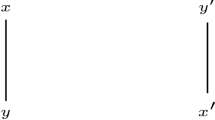Abstract
We define the torsion element in effect algebras and use it to characterize MV-effect algebra and 0-homogeneous effect algebras in chain-complete effect algebras. As an application, we prove that every element of an orthocomplete homogeneous atomic effect algebra has a unique basic decomposition into a sum of a sharp element and unsharp multiples of atoms. Further, we characterize homogeneity by the set of all sharp elements in orthocomplete atomic effect algebras.
Similar content being viewed by others
References
Dvurečenskij A, Pulmannová S (2000) New trends in quantum structures. Kluwer, Dordrecht
Foulis DJ, Bennett MK (1994) Effect algebras and unsharp quantum logics. Found Phys 24:1331–1352
Goodearl KR (1986) Partially ordered abelian groups with interpolation. American Mathematical Society, Providence
Gudder S (1998) Sharply dominating effect algebras. Tatra Mt Math 15:23–30
Jenča G, Riečanová Z (1999) On sharp elements in lattice ordered effect algebras. BUSEFAL 80:24–29
Jenča G (2001) Blocks of homogeneous effect algebras. Bull Aust Math Soc 64:81–98
Jenča G, Pulmannová S (2002) Quotients of partial abelian monoids and the Riesz decomposition property. Algebra Univ 47:443–477
Jenča G, Pulmannová S (2003) Orthocomplete effect algebras. Proc Am Math Soc 131:2663–2672
Jenča G (2010a) 0-Homogeneous effect algebras. Soft Comput 14:1111–1116
Jenča G (2010b) Sharp and meager elements in orthocomplete homogeneous effect algebras. Order 27:41–61
Kôpka F, Chovanec F (1997) Boolean D-posets. Tatra Mt Math 10:1–15
Markowsky G, Rosen BK (1976) Bases for chain-complete posets. IBM J Res Dev 20:138–147
Ravindran K (1996) On a structure theory of effect algebras. PhD thesis, Kansas State University, Manhattan
Riečanová Z (2002) Smearings of states defined on sharp elements onto effect algebras. Int J Theor Phys 41:1511–1524
Riečanová Z (2003) Continuous lattice effect algebras admitting order-continuous states. Fuzzy Sets Syst 136:41–54
Riečanová Z (2005) Basic decomposition of elements and Jauch–Piron effect algebras. Fuzzy Sets Syst 155:138–149
Riečanová Z, Wu J (2008) States on sharply dominating effect algebras. Sci China Ser A 51:907–914
Tkadlec J (2008) Atomistic and orthoatomistic effect algebras. J Math Phys 49:053505
Acknowledgments
The research was supported by the Natural Science foundation of Shaanxi Province under Grant No. 2007A19 and the foundation of Shaanxi Province Education Ministry under Grant No. 08JK472.
Author information
Authors and Affiliations
Corresponding author
Rights and permissions
About this article
Cite this article
Ji, W., Xin, X.L. Torsion elements in effect algebras. Soft Comput 15, 2501–2505 (2011). https://doi.org/10.1007/s00500-011-0712-5
Published:
Issue Date:
DOI: https://doi.org/10.1007/s00500-011-0712-5




